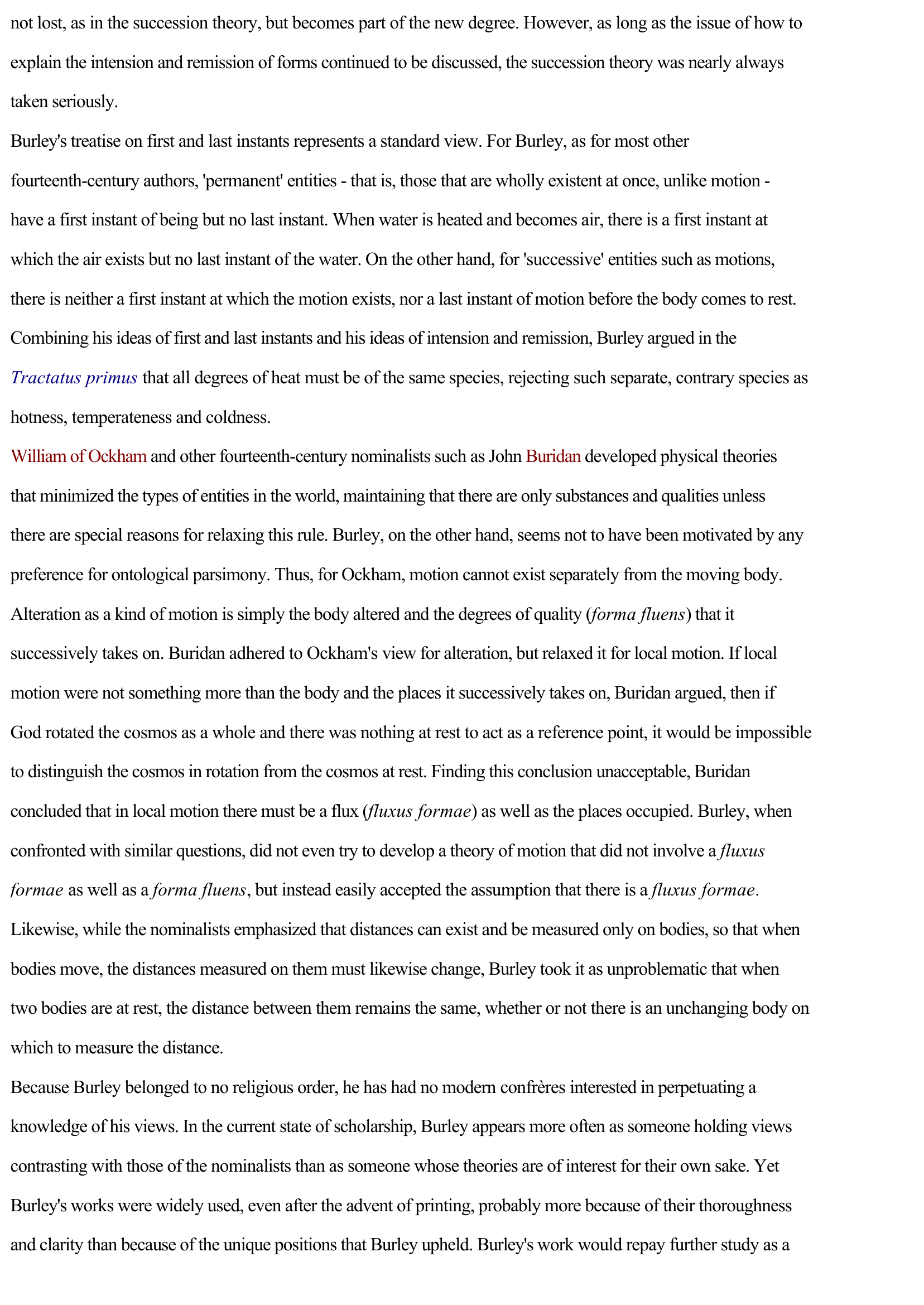Burley, Walter
Publié le 22/02/2012

Extrait du document
«
not lost, as in the succession theory, but becomes part of the new degree.
However, as long as the issue of how to
explain the intension and remission of forms continued to be discussed, the succession theory was nearly always
taken seriously.
Burley's treatise on first and last instants represents a standard view.
For Burley, as for most other
fourteenth-century authors, 'permanent' entities - that is, those that are wholly existent at once, unlike motion -
have a first instant of being but no last instant.
When water is heated and becomes air, there is a first instant at
which the air exists but no last instant of the water.
On the other hand, for 'successive' entities such as motions,
there is neither a first instant at which the motion exists, nor a last instant of motion before the body comes to rest.
Combining his ideas of first and last instants and his ideas of intension and remission, Burley argued in the
Tractatus primus that all degrees of heat must be of the same species, rejecting such separate, contrary species as
hotness, temperateness and coldness.
William of Ockham and other fourteenth-century nominalists such as John Buridan developed physical theories
that minimized the types of entities in the world, maintaining that there are only substances and qualities unless
there are special reasons for relaxing this rule.
Burley, on the other hand, seems not to have been motivated by any
preference for ontological parsimony.
Thus, for Ockham, motion cannot exist separately from the moving body.
Alteration as a kind of motion is simply the body altered and the degrees of quality ( forma fluens ) that it
successively takes on.
Buridan adhered to Ockham's view for alteration, but relaxed it for local motion.
If local
motion were not something more than the body and the places it successively takes on, Buridan argued, then if
God rotated the cosmos as a whole and there was nothing at rest to act as a reference point, it would be impossible
to distinguish the cosmos in rotation from the cosmos at rest.
Finding this conclusion unacceptable, Buridan
concluded that in local motion there must be a flux ( fluxus formae ) as well as the places occupied.
Burley, when
confronted with similar questions, did not even try to develop a theory of motion that did not involve a fluxus
formae as well as a forma fluens , but instead easily accepted the assumption that there is a fluxus formae .
Likewise, while the nominalists emphasized that distances can exist and be measured only on bodies, so that when
bodies move, the distances measured on them must likewise change, Burley took it as unproblematic that when
two bodies are at rest, the distance between them remains the same, whether or not there is an unchanging body on
which to measure the distance.
Because Burley belonged to no religious order, he has had no modern confrères interested in perpetuating a
knowledge of his views.
In the current state of scholarship, Burley appears more often as someone holding views
contrasting with those of the nominalists than as someone whose theories are of interest for their own sake.
Yet
Burley's works were widely used, even after the advent of printing, probably more because of their thoroughness
and clarity than because of the unique positions that Burley upheld.
Burley's work would repay further study as a.
»
↓↓↓ APERÇU DU DOCUMENT ↓↓↓
Liens utiles
- Griffin, Walter Burley - architecture.
- Le personnage de SHANDY Walter
- ROB ROY (Robert Campbell Mac-Gregor dit). Personnage de Rob Roy de Walter Scott.
- ANNE DE GEIERSTEIN ou La fille des brumes de Walter Scott (résumé & analyse)
- Walter de la Mare : VERRE BRÛLANT (Le) ET AUTRES POÈMES [The Burning Glass and Other Poems]. (résumé)

































